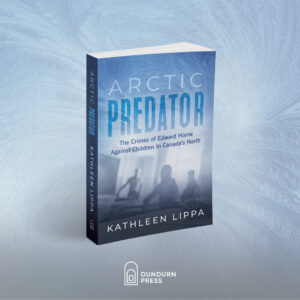
Arctic Predator: The Crimes of Edward Horne Against Children in Canada’s North by Kathleen Lippa
Dundurn Press
Review by Brian Tanguay
What most impressed me about Arctic Predator, journalist Kathleen Lippa’s book about the crimes of notorious sexual predator Edward Horne, is her determination to investigate and report such a dark, disturbing story. Reporting on events that happened only a few years ago is challenging enough, going back decades requires total commitment to the truth — even more so in cases of sexual crimes against children where the law seeks to protect victims by restricting public disclosure. Lippa, who dedicates the book to the children of the North, made an extraordinary commitment to telling the story of Indigenous victims and their communities. Such stories are rarely deemed important enough to tell.
Arctic Predator is a reminder that events took place that caused damage and pain to vulnerable children, and affected a web of relationships. It’s the kind of damage and pain that isn’t necessarily visible and rarely ever heals. Deep trauma that plagues Horne’s surviving victims as they enter middle-age. Understanding the consequences of Horne’s crimes requires that one keep in mind the remoteness of Canada’s north and the interconnectedness of its inhabitants. Bonds of blood and marriage, place, culture and language create an insularity that magnifies significant or unusual events, deepens their impact and reverberation, etching them into collective memory.
In the far north in the last few decades of the twentieth century, a white teacher like Ed Horne was a figure of benevolent authority, trusted in the way priests were once trusted. If that teacher was intelligent and knew how to present himself, as Horne did, he could win trust. Horne claimed Indigenous heritage, spoke and wrote Inuktitut, a rare skill at the time, and married an Inuit woman, which provided some cover against the rumors and warning signals that trailed him. Horne had little trouble securing a string of teaching positions, and in an analog age in a geographically remote region, he usually moved with his reputation as an effective and innovative teacher intact. It took time for the trail of broken trust, broken lives, and broken laws to finally catch up with him.
Why it took so long is a big part of this story. People knew there was something suspect about Ed Horne.
In some of the remote places Horne taught, his was often one of the few homes with hot water, a shower, TV, reliable electricity. He always had food and things to offer the children who visited his home. He took advantage of his position and its perks to sexually abuse dozens of young Inuit boys in different communities; abused them in his home, inside their school, turning these places into museums of horror.
When Horne was finally arrested he confessed to many of his crimes. He was convicted and served time in prison, but the consequences of his depredations didn’t end. Civil lawsuits for negligence against local and regional governments followed, which meant reopening wounds many wished to forget. Monetary damages were awarded to some of Horne’s victims.
I had never heard of Ed Horne before reading this book. What comes through Lippa’s interviews and correspondence with Horne, court documents and witness statements, is a sense of complexity and recognition of the many guises a single human being can present to the world. Horne was intelligent and curious, but at the same time cruel and morally blind. Tragically wounded may be the most generous description of Horne.
Telling this story required something else which is under threat all over the world: a commitment to the profession of journalism and the belief that its practice matters and can contribute to understanding, bring about change, and even secure a measure of justice. I think of the obstacles Kathleen Lippa had to overcome. Memories fade, recollections conflict, victims and witnesses pass away, migrate, refuse to talk to a reporter; primary sources of information become lost or destroyed over time. As well I think of broad distances and icy darkness that swallows the innocent along with the accused. Entering that icy darkness requires courage.